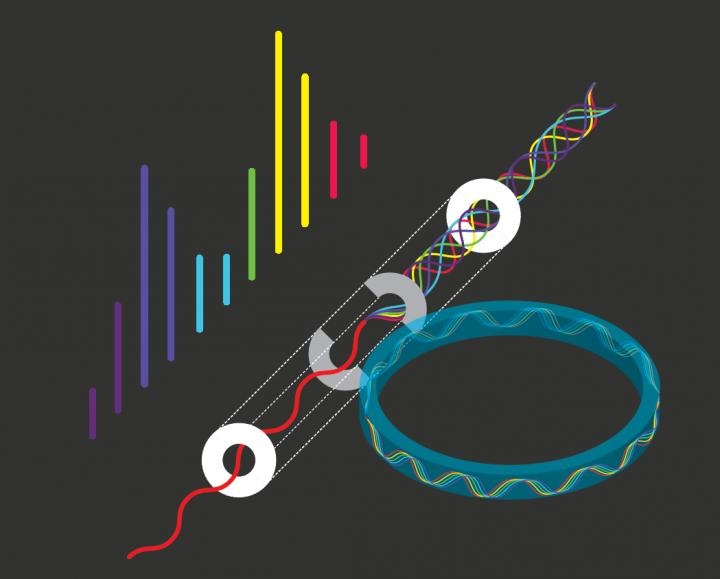Jan 25 2018
A new mathematical model describing the process of soliton occurrence in optical microresonators has been developed by a team from the Faculty of Physics of the Lomonosov Moscow State University, along with the scientists from the Russian Quantum Center. After understanding the existing effects and learning to predict new ones, the physicists will be able to develop universal optical oscillators and high-precision devices. The work was featured in Optics Express journal.
 Forming a comb in a microresonator associated with an optical waveguide. (Image credit: Mikhail Gorodetsky)
Forming a comb in a microresonator associated with an optical waveguide. (Image credit: Mikhail Gorodetsky)
One year ago, a team of scientists headed by Mikhail Gorodetsky, a professor of the Faculty of Physics, MSU and the Scientific Director of RQC, created a method for controlling the number of solitons in the so-called optical microresonators. Microrsonators are considered to be the basis of modern photonics - a science specializing in optical signals. A resonator is a ring-shaped trap for light, in which a photon grazingly reflects a number of times from the walls and then moves in circles.
Solitons are solitary localized waves that can be seen in resonators if the refraction index of a resonator's building material is found to be non-linear and is a certain function of the wavelength. In this case, a laser beam, after making several rounds within a resonator, divides into separate solitons (that is, auto-focuses and then turns into femtosecond-long pulses).
When employing these resonators, scientists are particularly interested in the so-called soliton "optical combs" - originating in resonators with a typical comb-shaped optical spectrum, in which the distance between two neighboring peaks is equal to the inversed time the light needs to produce the whole circle. Such combs could be employed in solving several applied problems.
The problem is that the existence of useful combs in resonators based on magnesium fluoride (MgF2) or fused silica, is linked with several harmful effects. These compromise the so-called Raman or combinational scattering. It is brought about by oscillations of individual molecules in a substance. After arriving at the surface of such a substance, light is reemitted with another wavelength. The effect has a threshold, based on the composition of the substance and the intensity of radiation, and causes spectrum distortion and the destruction of solitons. In the new paper, the research team studied the nature of this effect and then created new equations that describe the production of optical combs, taking into account Raman scattering. The system of equations could be used for numerical simulation of the effects that take place in optical resonators.
We used these equations to check the behavior of light in resonators with anomalous dispersion and obtained previously known effects. Thus, we've tested our theory. After that we applied it to combs with normal dispersion that have platicons (pulses with plateau-shaped peaks of spectrum) instead of solitons.
Professor Mikhail Gorodetsky
The new model permitted the scientists to predict a number of earlier unknown effects. For instance, in the case consistent dispersion pulses are majorly distorted due to Raman scattering. The production of mathematical tools is vital for enabling the scientists to comprehend how to attain optical combs in environments with steady dispersion that is characteristic for the majority of substances found around human beings. Additional experiments are expected to establish the conclusions on the example of platicons.
Currently, there are only a few labs in the world that study soliton combs. Together with our Swiss colleagues we were the first to demonstrate them. Recently they have been widely used, in particular in high-accuracy spectroscopy, to increase the speed of information exchange, in telecom networks, and in lidars. Some time ago German scientists used optical combs to accurately determine the shape of a moving bullet and managed to see how it changes due to air resistance.
Professor Mikhail Gorodetsky
Optical combs open prospects of producing optical oscillators, based on only one chip and emitting light with any preset frequency, which is not possible for modern lasers and various other generators. Furthermore, they may function as a basis for pocket-type spectrometers employed for analyzing the composition of substances. Presently, this task needs quite huge devices.